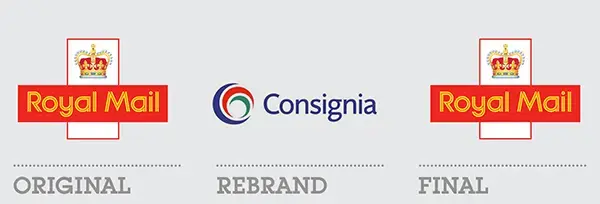When rebranding goes wrong: Case studies across the globe
- trubranders
- Jul 20
- 3 min read

Why some changes spark excitement—while others ignite outrage.
Before we dive in—think back.Have you ever walked into a store, looked for your favorite product, and paused, confused, thinking:
“Wait, did they change something?”
You’re not alone. Rebrands can be powerful. But when mishandled, they create confusion, frustration—and sometimes, a PR nightmare.
Let’s explore the emotional rollercoaster behind real-world rebrands that didn’t land as planned.
1. Name Changes: What’s in a Name?
A lot more than companies expect.

Royal Mail → Consignia (UK, 2001)
Here’s a quick exercise:Imagine your country’s postal service changing its name overnight. No context. No warning. Just… gone.
That’s exactly what happened when Royal Mail, a trusted UK institution, became Consignia.
Public reaction?Most people didn’t even know how to pronounce it. Within 16 months, it was back to Royal Mail. Why? Because a name with 500 years of trust carries weight.
👉 Question for you: Would you trust a new name instantly if it replaced a brand you grew up with?

Sci-Fi Channel → Syfy
Think this one’s harmless? Not if you’re a die-hard science fiction fan.
Changing “Sci-Fi” to “Syfy” might look trendy—but fans felt like they were being pushed out of their own community. The brand they identified with no longer “spoke their language.”
It’s a subtle reminder: brand spelling might change—but emotional connection can’t be rebranded.

Andersen Consulting → Accenture
Now, this is how to do it right.New name, new era, global presence. But unlike the others, Accenture didn’t just launch a new name.
They tested it. They explained it. They prepared their audience.The result? A brand transformation that stuck—because the audience was invited along for the journey.
2. Logo & Packaging: Small Shifts, Big Reactions

Tropicana’s Orange Vanishes (2009)
Imagine picking up your usual orange juice and thinking:
“Is this even the same brand?”
That’s what happened when Tropicana replaced its iconic “orange with a straw” image.
The backlash? Loud and fast.Sales dropped by 20% in weeks. Customers didn’t even recognize the product.
Now ask yourself: Have you ever skipped buying something because it looked “off” or unfamiliar?
GAP’s Minimalist Logo (2010)
Within six days, they reversed it.Why? Because people felt like something was taken from them.
Design matters—but so does memory. Customers weren’t just reacting to a logo change; they were reacting to a shift in identity.
What would make you say: “This doesn’t feel like my brand anymore”?
RadioShack → The Shack
A name meant to be edgier turned out... vague.Without context, “The Shack” could mean anything. A beach bar? A burger joint?
Lesson: A new name without a clear message just adds more confusion.

3. Jaguar’s 2024 Rebrand: Brave or Blind?
Now, let’s look at something fresh—and divisive.
In 2024, Jaguar stepped into new territory:
The iconic leaping jaguar logo? Gone.
A new monogram, edgy typography, and fashion-style ads took its place.
In some campaigns, the cars weren’t even shown.
If you were a lifelong Jaguar fan, what would you feel?Disoriented? Betrayed? Curious?
That’s exactly how the world reacted. Some called it bold. Many called it baffling.
Take a look at Jaguar’s rebrand timeline:
Year | Old Identity | New Identity | Reaction | Key Lesson |
1945 | SS Cars | Jaguar | Widely positive | A clean break from the past, with purpose |
2024 | Leaping Jaguar logo | JaGUar monogram & abstract slogans | Mixed to negative | Disconnect from legacy leads to emotional backlash |
Jaguar’s history of thoughtful reinvention (like the 1945 rename) stood in contrast to the abruptness of its 2024 rebrand.
Now consider: When a brand stops showing the product, what are they really selling?
So, What Can We Learn?
Rebrands succeed when they:
Respect the brand’s emotional roots
Bring customers into the journey
Align visual and verbal identity with the brand’s deeper story
They fail when they:
Prioritize “different” over “meaningful”
Assume customers will adjust, without helping them do so
Confuse aesthetic updates with strategic thinking
Over to You
Have you ever been disappointed—or delighted—by a rebrand?Which of these stories resonated with your own experiences as a customer?
What makes a rebrand feel right to you?
Drop your thoughts, or take this question to your team:If we changed our logo or name tomorrow, what would our audience miss most?
If you’re planning a rebrand, make it intentional. Make it human.And most importantly—make it with your audience, not just for them.
Let’s make your brand transformation one people talk about for the right reasons. Why Expert Guidance Matters
Stories like these prove how powerful—and risky—rebrands can be. By involving an experienced brand naming agency and relying on professional brand naming services, companies can:
Safeguard legacy and customer trust.
Test and refine new names, visuals, and messaging.
Avoid the pitfall of change for change’s sake.



This post shared some valuable points about strategy and positioning. Businesses aiming to scale can also benefit from PathSeekers, a leading luxury brand agency offering premium guidance.